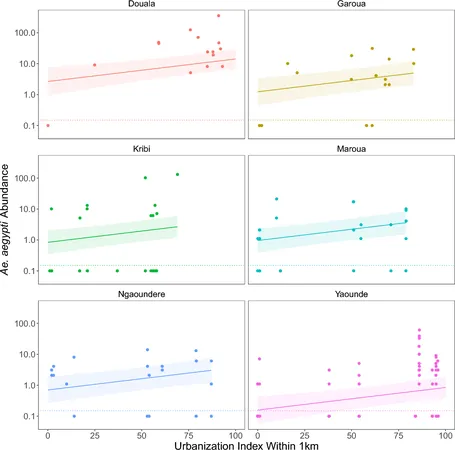
The Impact of Urbanization, Climate, and Rainfall on Mosquito Populations in Central Africa: A Deep Dive into Aedes Aegypti and Aedes Albopictus
2025-04-06
Author: Sarah
Introduction
As urban areas rapidly expand, they bring significant changes to ecosystems, particularly in Africa where urbanization rates are among the highest globally. This transformation can drastically affect disease vectors like mosquitoes, potentially increasing their abundance and altering the dynamics of pathogen transmission. Our study explores the effects of urbanization, weather conditions, and rainfall on two key mosquito species, Aedes aegypti and Aedes albopictus, across 63 sites in six major cities in Cameroon, spanning a 900-km latitude range.
Research Methods
To assess mosquito populations, we conducted human landing catches and employed backpack-mounted aspirators for sampling. In addition to mosquito collection, we gathered data on potential larval habitats, availability of hosts, and various weather metrics including temperature, precipitation, and humidity. Using satellite imagery and land use analyses, we quantified urbanization with a continuous urbanization index (UI), where a higher score indicated a greater proportion of impermeable surfaces and less vegetative cover.
Findings
Our analysis revealed a consistent trend: urbanization leads to increased abundance of Aedes aegypti mosquitoes. Specifically, each unit increase in the urbanization index correlated with a 1.7% rise in the abundance of this species, with substantial increases—up to 5.4 times—from areas of low to high urbanization. Furthermore, rainfall played a crucial role, as higher precipitation levels also contributed to greater mosquito populations.
In contrast, the response of Aedes albopictus was less predictable. While it thrived in more urbanized areas in one city, its populations showed no significant trend in two other cities. Interestingly, Aedes albopictus abundance was positively influenced by temperature and humidity across three cities.
In our extensive sampling, we did not find any evidence of Zika, dengue, or chikungunya viruses in either mosquito species, raising questions about pathogen dynamics in urban areas. Despite extensive testing, the absence of these viruses was remarkable, particularly given existing human cases reported in Douala during our study.
Discussion
Our findings indicate that urban environments provide favorable conditions for Aedes aegypti, likely due to increased larval habitats linked to human activities like waste disposal and water storage. Urbanization not only modifies available habitats but also boosts the presence of human hosts—critical factors for mosquito proliferation. In fact, human population density was found to correlate strongly with Aedes aegypti abundance.
Conversely, Aedes albopictus exhibited a more varied response to urbanization, hinting at a complex interaction between species and environmental factors. This could reflect differing ecological strategies or competitive behaviors—an area ripe for further research.
Conclusion
As Africa continues to urbanize at an unprecedented rate, we can expect Aedes aegypti populations to rise in tandem, posing increased risks of vector-borne diseases. Additionally, climate change may further complicate these dynamics through altered precipitation patterns and temperature variations. Monitoring mosquito populations and understanding the multifaceted impacts of urbanization will be essential for effective vector control and public health initiatives.
Future Directions
Future studies should seek to explore the potential for interspecific competition between Aedes species and investigate how variations in urban landscapes affect mosquito health and pathogen transmission. Furthermore, applying innovative vector control strategies in urban settings may lessen human exposure to these disease-carrying mosquitoes.
In summary, while urbanization accelerates the proliferation of Aedes aegypti in Central Africa, the implications for public health due to mosquito-borne diseases cannot be underestimated—engaging communities in mosquito control efforts and investing in research will be crucial for safeguarding health in this rapidly changing environment.


 Brasil (PT)
Brasil (PT)
 Canada (EN)
Canada (EN)
 Chile (ES)
Chile (ES)
 Česko (CS)
Česko (CS)
 대한민국 (KO)
대한민국 (KO)
 España (ES)
España (ES)
 France (FR)
France (FR)
 Hong Kong (EN)
Hong Kong (EN)
 Italia (IT)
Italia (IT)
 日本 (JA)
日本 (JA)
 Magyarország (HU)
Magyarország (HU)
 Norge (NO)
Norge (NO)
 Polska (PL)
Polska (PL)
 Schweiz (DE)
Schweiz (DE)
 Singapore (EN)
Singapore (EN)
 Sverige (SV)
Sverige (SV)
 Suomi (FI)
Suomi (FI)
 Türkiye (TR)
Türkiye (TR)
 الإمارات العربية المتحدة (AR)
الإمارات العربية المتحدة (AR)